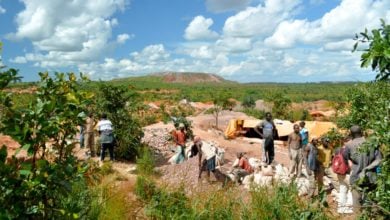For decades, Chinatowns across the United States have been under attack by racist capitalist developments. Developers, banks and politicians are competing to construct the newest arenas, the tallest mega-jails and the grayest luxury apartment condos. These seemingly upscale yet unsafe and unsound projects have effectively priced out long-time residents and small businesses. Capitalist developments have destroyed entire communities — places where people used to live, gather, and thrive — now sit as empty vessels and lifeless tourist destinations. For the few Chinatowns in which working-class immigrants and families still reside, rabid gentrifying forces are pushing the local residents to fight for their lives.
Profiteering developments are just one instance of the extensive social phenomena threatening our Chinatowns. Notably, the COVID-19 pandemic, combined with a right-wing propaganda campaign, ignited anti-Asian sentiments and hate crimes. Countless acts of violence, most of which targeted women and the elderly, took place within and around Chinatowns across the country. Victims of these hate crimes were shoved off subway platforms and sidewalks, beaten with objects, and dehumanized with racial slurs.
Mainstream media portray these assaults as supposedly senseless incidents and reduce them to individualized racial “hate.” They exalt that the solution to these problems is to increase crime reporting, expand police budgets, and to strengthen the system of mass incarceration. The news media is cynically manipulating the plight of Asian Americans to promote reactionary “tough on crime” policies.
Capitalists are opportunistically banking on the latest rise of anti-Asian violence to drive a wedge between oppressed communities, as a means to keep them divided and powerless. This strategy of racial division is part of the larger profit scheme to encroach on Chinatowns by dividing communities fighting for the same right to housing.
Chinatowns under existential threat
The growth of Chinatowns in the United States can be traced back to the mid-19th Century, when Chinese laborers began arriving in large numbers to work on the transcontinental railroad and other industries. This first wave of immigrants faced widespread discrimination and were forced to form ethnic enclaves. Overtime, these communities evolved into the Chinatowns that we know today, which are characterized by a rich cultural heritage.
However, in recent decades, the development of Chinatown has taken on a new character, one driven by capitalist greed and speculative development. Gentrification is the tool that the ruling class will use to try and wipe Chinatowns off of the map. This racist process erases cultural identity and reinforces patterns of segregation and exclusion.
In 2017, then NYC Mayor Bill de Blasio approved an $8.3 billion construction plan to build the world’s tallest jail. Standing at 300 feet above-ground with an ominous 40-story façade, the city’s vibrant Chinatown will be engulfed in the shadows of the mega-jail. It is already vile that public funds are further used to fuel mass incarceration instead of being spent on taxpayers for education, health care, infrastructure, and other social service programs. Yet it is even more sinister to build this jail in Chinatown, a densely populated area home to low-income immigrants, workers, families, and others facing economic hardships.
Similarly in Philadelphia, the billionaire developers of 76DevCorp are attempting to build a basketball arena right on the border of the city’s Chinatown. This $1.3 billion plan that would involve ten years of construction is predicted to slowly wipe out the only remaining low-income neighborhood in Philadelphia’s city center.
David Adelman, one of the key developers involved in the stadium proposal, is also the CEO of Campus Apartments, a notorious development company that is the main engine behind the University of Pennsylvania’s efforts to displace West Philadelphia’s mostly Black, working-class population. The privatization of student housing and perpetual university expansion across the city extends beyond Philadelphia. David Blitzer, one of the owners of 76ers, sits as a global executive at Blackstone Inc., the world’s largest corporate residential landlord group. Blackstone has been exposed by the United Nations for contributing to the global housing crisis and for committing numerous human rights violations. The Wall Street private equity firm is also lobbying the Pentagon and State Department on issues related to military preparedness and training.
A similar situation happened in Washington D.C., where a once bustling Chinatown effectively disappeared when the Capital One Arena propped up in the middle of the neighborhood. San Francisco’s Chinatown, the oldest Chinese community in the U.S., faces constant displacement threats as greedy landlords and management companies attempt to drive out low-income, immigrant tenants. Located in one of the most intensely gentrified cities, Boston Chinatown’s row homes, which traditionally housed the community’s most vulnerable members, continues to fight against evictions by private development. The list of profit-seeking developments in and around Chinatowns goes on and on, and they are all malignant symptoms of the same racist, capitalist system that dictates almost all aspects of our lives and disregards our communities.
U.S. empire feeds anti-Chinese sentiments and policies
While on one side working class Chinese and other Asian communities are being squeezed by the forces of capitalist development, on the other side a repressive and racist atmosphere in society is being fomented as part of U.S. imperialism’s new Cold War. Red-baiting, anti-communist indoctrination, sinophobia, and terror attacks against Asian people are all deeply connected to the historical and contemporary contexts of U.S. imperialism in Asia. Time and again, when another country becomes the target of U.S. imperialism and aggression, we observe vicious attacks directed at immigrants.
The dehumanization of Chinese and other Asian people saturates corporate media, and consequently conditions the American consciousness and further ingrains racism and bigotry on a systemic level. The media’s reprehensible endorsement of anti-Asian racism is clearly an attempt to manufacture consent for a new Cold War with China.
In recent years, U.S. foreign policy has ramped up its focus on the Asia-Pacific as the central feature of its imperialist agenda. China is no longer available to be extorted and exploited in a way desired by the U.S. ruling class, as it has established itself as a legitimate pole of autonomous development. China is led by a communist party and its government was established through a socialist revolution in 1949, giving an additional dimension to the conflict.
Learning lessons from the last Red Scare
During the era of McCarthyism, Chinese-Americans became victims of the anti-communist hysteria, a story that was classified as top secret by the U.S. government for over four decades.
In the early 1950’s, months after Mao Zedong established the People’s Republic of China, the U.S. State Department launched a campaign against Chinese-Americans. The following two decades were fraught with rampant racial persecution and anti-China hysteria. The McCarthy anti-communist witch hunt rampaged through Chinatowns in search of Chinese communists and sympathizers. Working alongside campus police departments, the FBI raided universities and student clubs in search of Asian-American radicals.
Scholars and researchers were investigated by the House of Un-American Activities Committee (HUAC), blacklisted, and often stripped of their resident permits and citizenship. The Red Scare robbed people of their freedom to communicate with their relatives in Asia, speaking positively of their homeland, and expressing their ethnic and cultural identity. Economic sanctions against China forbid ordinary Chinese-Americans from sending money to support their family back home. It forced Chinatown businesses to shut down and communities to withdraw from society, out of fear of Cold War suspicion.
A new Cold War
U.S. aggression on China takes many forms, including trade wars, military posturing, and political pressure designed to prevent China from challenging U.S. dominance in the global economy. We are in a new Cold War and along with it a propaganda campaign prone to become more and more absurd, and which intentionally — and gradually — blurs the distinction between individuals and states.
This aggression has had a profound impact on Chinatowns, which have become key sites of economic and political competition. The Covid-19 pandemic was politicized to such an extreme degree that people experienced significant harm, especially in Chinatowns across the country. Individuals and businesses were violently attacked, and many businesses were forced to close when people stopped dining and shopping in Chinatowns. The downstream effects meant that workers lost their jobs, and the terrain was left more ripe for gentrification. It is not hard to see how, as the United States further escalates its attacks on China, these problems can escalate into more organized attacks, ones which operate with government and corporate support.
Our Chinatowns are home to tightly-knit networks of recent immigrants and workers who deeply support one another in a fight to survive. They provide places to work and to feel safe. Chinatowns are also home to dynamic and militant political organizing. The forces that want to destroy Chinatowns target our children, colleagues, mothers, and elders. They shut down schools, research centers, and cultural institutions. We need to simultaneously organize the working-class to resist predatory development, and fight back against the U.S. politicians and capitalist elites who are beating the drums of war and pushing for global destruction.






